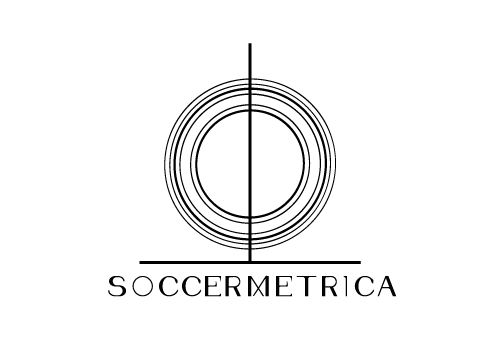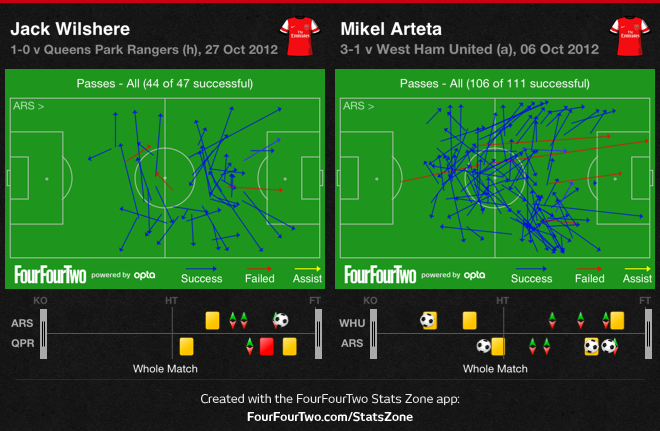Both managers played their normal 4-2-3-1 formations. Arsene Wenger gave Theo Walcott the start over Aaron Ramsey on the right. Andre Santos had a miserable night at left back when Schalke beat Arsenal 2-0 a fortnight ago so Wenger shuffled Thomas Vermaelen to left back and brought in Laurent Koscielny to play along side Per Mertersacker in the center of defense.
The only change Huub Stevens made to his team from the last time these sides met was swapping Marco Hoger with Jermaine Jones.
Early Moments
In the opening 15 minutes of the game both teams got players behind the ball defensively rather than pressing. Both back fours pushed forward towards the bank of midfielders, keeping the space the opposition had to play in very compact. The two sets of holding midfielders sat close in front of the back four and checked runs into that area. It appeared both managers were concerned about giving the opposition center attacking midfielder space in between the seams. This makes sense. Both Santi Cazorla and Lewis Holtby are clever at finding pockets of space and have the ability to pick out decisive penetrating passes. It also wasn't all that surprising both teams had set up to counter. Away from home Arsenal didn't want to open themselves up too much in the early stages and expose themselves to counters. Schalke are terrific at breaking forward quickly through Holtby, Ibrahim Afellay and Jefferson Farfan and constantly looked dangerous on the counter when the teams met in London.
It was also apparent in the early stages that Arsenal were placing responsibility on Lucas Podolski and Walcott to drop in defensively and provide help to Vermaelen and Bacary Sagna. Schalke like to get their outside backs forward and when these teams last met a fortnight ago, Podolski did a poor job tracking Uchida when he advanced forward from right back. This left Andre Santos, a left back not known for his defensive qualities, exposed to overloads with Uchida and Farfan. Farfan had found it easy to get around Santos and cut in towards the near post all evening and Schalke created a number of dangerous chances from the right. With Podolski and Walcott recovering to help defensively this time around, Farfan and Afellay did not enjoy the same amount of space on the flanks early on they had at the Emirates.
Arsenal go 2-0 up
Arsenal went up 2-0 inside half an hour without ever looking especially threatening. The opener on 16 minutes came from a comedy of errors- Neustadter's failed back header put Giroud through on goal only for the Frenchman to get his attempt on goal horribly wrong; his blushes spared however when the ball fell kindly for the trailing Walcott. Schalke were then forced to replace Uchida at right back on 25 minutes, bringing in Hoger, a midfielder by trade. Hoger's defensive weaknesses were exposed immediately. Within a minute of his introduction he was beaten easily by Podolski on the left who played in an expert cross to the front post for Giroud to head home. Neither goal was particularly indicative of an overarching tactical battle that had been emerging- the first was simply a bad mistake from Neustadter, the second poor defending from Hoger coupled with a training ground cross and finish combination from Podolski and Giroud. It should be noted however that Arsenal's second started with a move that saw Jack Wilshere receive a pass level with the Schalke back four, highlighting his ability to play as a box-to-box midfielder and join in the attack around the penalty area.
The early goals did however change the tactics for the remainder of the game. At 2-0 up away from home, Walcott and Podolski began dropping even deeper to provide defensive cover. With Schalke now forced to chase the game, they began to push the outside backs Fuchs and Hoger higher up the field. In defense, Arsenal set up in a 4-4-1-1 with Walcott and Podolski picking up Fuchs and Hoger. Everything seemed to be going right for the Gunners. Their more defensive shape prevented Schalke from doing what they do best- counter attack. When they won possession back they looked to find Cazorla in pockets of space in front of the center backs where he could turn and start counterattacks. Walcott and Podolski tried use their pace to advanced past Fuchs and Hoger down the channels, leaving the Schalke center backs scrambling to defend the width of the pitch. Arsenal didn't get many opportunities to counter but their defensive shape was forcing Schalke to play the ball horizontally in midfield and the German side didn't look particularly threatening.
Schalke's opener in first half stoppage time was such a blow because it came at a time when Arsenal were defending rather comfortably and on a move in which it appeared they were set to execute their plan and launch a counter through Cazorla. Arteta won the ball off Schalke at his own 18 and found Cazorla in space between the Schalke midfield and center backs. The Spaniard lost his footing however (he did several times throughout the night) and Schalke recovered the ball with the Arsenal defense out of shape. Holtby received a waist high pass at the edge of the 18 that he laid down brilliantly for Huntelaar to tuck home. Defending a one goal lead was never going to be an easy task for Arsenal in the second half.
Second Half
Schalke were very adventurous with the positioning of their outside backs to start the second half. Podolski and Walcott continued to drop in deep but Fuchs and Hoger would still at times advance past them. Afellay and Farfan were dangerous when they got on the ball and cut inside, creating room for overlapping runs from the outside backs. Schalke's equalizer came when Walcott had drifted infield to help defend the middle of the park. The ball went wide to an unmarked Fuchs. Sagna felt the need to close him down quickly (maybe not the best option as Fuchs was still 45 yards from goal), leaving empty space down the left channel for Afellay to run into. Mertesacker elected not to leave his position in the box and instead allowed Afellay to pick his head up and fire a cross into the box. It found Hotby who headed it into the path of Farfan for the goal. Once again defending the channels had proved Arsenal's undoing.
After the equalizer both sides seemed content with the draw and the final 20 minutes were fairly uneventful.
Substitutions
Neither manager used his substitutions to alter the game. Stevens was forced into replacing his right back twice when Uchida and Hoger both went down to injury. Wenger didn't make a change until the 90th minute.














